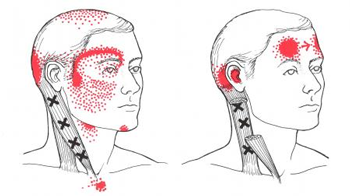When experiencing pain around the head, we talk about Headaches.
Headache is a common condition, and for most cases, is not considered a serious illness.
Migraine and headache.
4.9 million Australians experience migraine.
Migraine is a specific type of headache, so consider that the number stated above is still a small figure.
Headache and muscle.
If you ever experience a headache, you may notice that the pain sensation does start from your cervical area.
Or, by confronting yourself with who is around you, your headache pain pattern, is consistent, but it is different from the one of someone else.
On the other hand, you may associate headaches to the result of a heavy drinking night, or of lack of water (which is why you get headaches after a heavy drinking night, by the way), but often headaches are there because of cervical muscle tightness.
Wait, what?
Yes, you did read right.
How can we define then if the headaches come from muscle tension?
So in order for this to happen, the muscle responsible for referring its pain up to the head must be tight or stretched out, and loaded with trigger points.
As massage therapists, especially in the first consultation session, we would ask about headaches and if there are any, “where about do you feel the headache”?
Indeed, the answer to this question is most luckily the giveaway to know which muscle is may responsible for your headaches.
To confirm the suspicions, we would then assess your posture, looking for any muscular-skeletal unbalance, and then we would assess the Range of Motion (ROM).
If the ROM show up to be limited on the muscle that we believe is responsible for the pain in the head, then most luckily we are halfway through the solution.
I do say halfway through, a single massage session either Myotherapy, Remedial Massage, Thai Massage, or MLD is maybe not enough to release all the tension that is in needs to be alleviated to eradicate the headache.
Said so, no journey starts, without doing the first step, isn’t it?
When a headache is a Red Flag?
For red flags, we refer to symptoms that may be present due to serious illness or condition.
Some example includes clients who had a clinical history of stroke and or brain cancer, a recent car accident or recent head trauma, or blurred vision.
If that’s the case, the next step is referring the client to a GP immediately for further investigation.
What about the cervical muscle tension headaches type of presentation?
As already mentioned in another blog post, the Occipital muscle can have headache type of pain in the lower section of the posterior side of the skull.
If we then look into the area of the skull that seat above the ear, could be more tension from the Upper trap or Levator Scapulae.
By keep moving more medially and above the head, Splenius cervis can refer to the medial superior side of the head and Splenius capitis to the middle top side of the head.
Sternocleidomastoid, indeed, can refer to the frontal lobe of the skull.

Now, all these muscles are sitting on the neck and throat and from above the shoulder.
So, ensuring that those areas are free or not overloaded with tension can help in staying headache-free.
Now, in this blog post, we are keeping the headache presentation type of pain to its simple aspects.
On the other hand, the topic can be further discussed in person with Giovanni during your next massage appointment.
Book now your next massage session, if you are trying to get to sort out your headache presentation.
Other approaches to a headache-free life, out of massage therapy.
There is a series of things that complimentary massage can help with to relieve headache pain.
- Exercises
- Keep yourself hydrated
- Good posture when seating and standing
- Good variety of food as diet intake
- Wearing glasses if needed.
- Meditation for stress management
In conclusion, headache is a really common problem for all Australians, for both women and men.
Don’t wait for your symptoms to get worse; you may not need to take medicine all the time if you have a headache, as the medicine will just numb the symptom but will not sort out the problem.